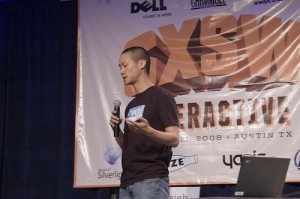Zappos CEO Tony Hsieh (pronounced “shay”) is a smart, friendly guy. In 1994 he started a business selling pizzas. Today, Zappos sells upwards of a billion dollars worth of shoes per year. Tony attributes much of Zappos success to one core element: company culture. Every Zappos employee, from the stock-room to the board-room, understands the company culture and it’s primary tennant: awesome customer service.
The slides from Tony’s SXSW presentation are here.
Some nuggets from Tony:
- People may not remember what you did or said, but they’ll remember how you made them feel.
- It doesn’t matter what your core values are, but that you commit to them. Alignment is key.
- Perceived control and perceived progress make people happier. An example: Zappos has a 3-year process in place for employees to reach a certain job position. They broke the process into 3 smaller segments. The only difference being that the interstitial steps have names. Employee satisfaction improves.
- During the hiring process, prospective employees are asked “How lucky are you?” The answer to this question gives insight into how that person perceives the world and their life.
- After completing initial training, new Zappos employees are offered $2000 to quit. Very few take the cash-out. The folks that remain have given more thought to “Do I want to be here?” and Zappos avoids losing hiring/training costs of people that don’t stick around. Tony says “Not enough people are taking the money. We may have to increase the amount.”
Lawrence Lessig is known for his focus on technology and law, especially as it applies to copyrights. A couple of years ago, he announced his intention to change his focus from copyright matters to political corruption. Earlier this year, he helped launch Change Congress, a web based project aimed at educating people about the influence of money in the political system.
Consider any public office where it’s known that a politician has accepted donations from a special interest group. We immediately assume that there is a money-for-influence scheme at work here, regardless of how “good” we perceive this politician to be. We assume that this politician abandons personal convictions when presented with a check. Sure, this isn’t a groundbreaking observation, but it’s time we fixed things and removed this taint from the system. Money corrupts democracy.
Change Congress’ immediate concern is H.R. 801, sponsored by John Conyers. This proposal forbids the government from requiring scientists who receive taxpayer funds for medical research to publish their findings openly on the Internet. Government-funded (our tax dollars) research would be available solely via for-profit journals inaccessible by the general public. Maplight.org reports that Conyers is receiving disproportionate donations from the benefiting publishing interests.
In a semi-related note, Lessig really knows how to deliver a presentation. I’ve been referring to it as “Keynote ballet”. His timing is excellent, his slides are interesting and there’s not a bullet point in sight. Beautiful.
About the title: using # symbols is a trend that’s recently caught on in Twitter. It allows people to tag the context of their discussion. Use of these “hash tags” is hotly debated, but apppears to be here to stay. This post is inspired by panels I attended at SXSW Interactive 2009.
March 19, 2009 – 12:16 pm
I spent the last week at SXSW Interactive 2009 in Austin, TX. This was my second time attending. I’m still unpacking, physically and metaphorically, and I plan to post some thoughts and reactions over the next couple of days.
About the title: using # symbols is a trend that’s recently caught on in Twitter. It allows people to tag the context of their discussion. Use of these “hash tags” is hotly debated, but apppears to be here to stay.
I’ll start with the one of the sessions that I’ve been thinking about a lot these last couple of days. Author, journalist, futurist and “global microbrand” Bruce Sterling delivered his much-anticipated rant to a packed crowd. Bruce chastised us all for not doing enough. We’re all tweeting when we should be listening. We’re letting good art and good stories (and good publishers!) die by our inattention.
My takeaway from the session is this: I’m going to create more (things! not just digital artifacts). I’m going to try to be a better audience member and participant. I’m going to focus more on engaging people in conversation than just getting my point across. To quote Mr. Sterling: “Let’s talk about our relationship. Yours and mine.”
 photo by Roustem Karimov
photo by Roustem Karimov
